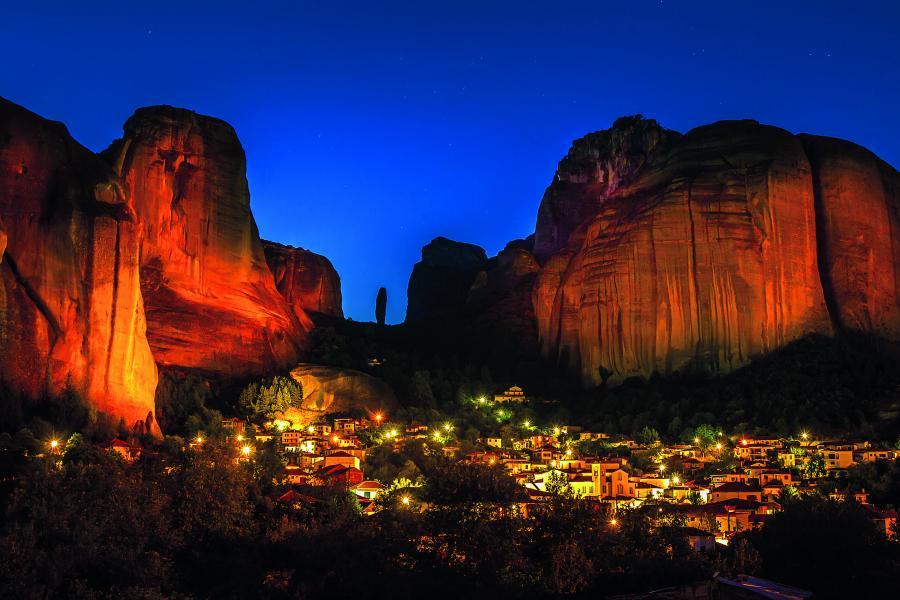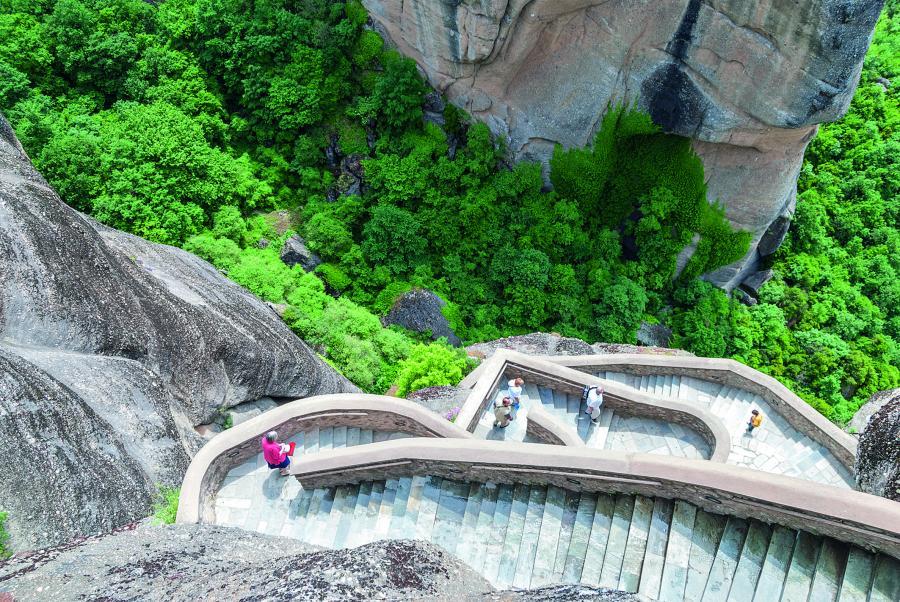Meteora: In God’s Country
Elaborately shaped by Mother Nature, perfectly balancing between heaven and earth, the “hanging rocks” in the plains of Thessaly watch time go by as they stand proud next to the city of Kalampaka.
Imposing and majestic, the Meteora complex is one of the most important symbols of the Christian religion and a breathtaking example of the mysterious ways in which the forces of Nature work. An awesome landscape, deeply carved in visitors’ memories, Meteora has been inspiring asceticism and the search of spiritual serenity for over seven centuries. These lonesome, proudly standing rocky giants have triggered artistic creativity, inspiring musicians, visual artists and, of course, cinematography experts, as numerous films and TV series have used Meteora as their natural setting. As for the digital era, Meteora has become an instagram sensation, since more and more amateur photographers flock in this unique place in order to capture impressive sunsets in a magnificent setting of vertical rocks and picturesque monasteries.
Genesis
According to the prevalent theory, the grayish rocky volumes of Meteora in the heart of Mainland Greece were formed approximately sixty million years ago, when the plains of Thessaly were covered by the sea. The streams concentrated large volumes of rocks and precipitates, resulting to the formation of large boulders on the bottom of the sea. The geological transformation of the following centuries elevated the area of Thessaly, creating the Tempi Valley, from where the water was channeled into the Aegean Sea. Continuous earthquakes and strong winds, corrosion, frost and high temperatures altogether shaped the dark-colored sandstone rocks that we see today.
Entry level
Built under the shade of these imposing rocks, Kalampaka constitutes the gate towards Meteora. The name of the city was Staghi during the Byzantine Era. Through the centuries, Kalampaka has been occupied by Romans, Serbians and Turks, from whom it was finally liberated in 1881. It is not until the 15th century that Kalampaka is being referred to under this name, as Kalampaka actually means “the rock with the monks’ capes” in Turkish. During the Second World War, the city was completely burnt down by the Nazi troops. Its contemporary aspect makes Kalampaka one of the most popular tourist destinations, with modern facilities and everything that one might need in order to enjoy the beauties of the greater area. Only one kilometer away from the city lies Kastraki, a picturesque village with traditional neighborhoods and narrow alleys, providing hotels, guesthouses, camping sites and taverns, allowing easy access to Meteora.
Holy Land
The wild beauty of this land and the inaccessibility of the rocks attracted Christian hermits, who settled there during the 10th c. AD. As a matter of fact, certain sources mention the establishment of the hermitage of the Holy Spirit in 950 AD by a Barnaby. In 1350, hermit Varlaam establishes the Monastery of the Three Hierarchs and All Saints, later followed by many other monasteries. Since late 15th c. AD and mainly during the 16th, Meteora experiences its most prosperous era, since new monasteries and monastic complexes are built –all including excellent hagiographies– reaching its peak in the 17th century, when the gradual decay begins. The following monasteries are the few that are still active nowadays:
- The male monastery of the Metamorphosis (Transfiguration) in Megalo Meteoro, built in 1372 on the largest rock of the complex, also known as Fardis Vrachos (“wide rock”). Opening hours (Winter): 09.00-16.00 except Tuesday and Wednesday. Τel.: (00) 30 24320 22278
- The male monastery of All Saints or Varlaam Monastery, the second largest monastery in Meteora. Opening hours (Winter): 09.00-15.00 except Thursday and Friday. Tel.: (00) 30 24320 22277
- The male monastery of Saint Nicholas Asmenos or Anapafsas Monastery, built 14th c AD. Opening hours (Winter): 09.00-14.00 except Fridays. Tel.: (00) 30 24320 22375
- The Male Monastery of Aghia Trias (Holy Trinity), built in 1362. Opening hours (Winter): 10.00-16.00 except Wednesday and Thursday. Tel: (00) 30 24320 22220
- The female monastery of Arsani or Roussanou Monastery, built 14th c AD. Opening hours (Winter): 09.00-14.00 except Wednesdays. Tel.: (00) 30 24320 22649
- The female monastery of Saint Stephen, built 15th c AD. Make sure not to miss the famous wooden carved temple of the catholicon, a magnificent example of detailed decoration. Opening hours (Winter): 09.30-13.00 & 15.00-17.00 except Mondays. Tel.: (00) 30 24320 22279
Info
A decent outfit is required in order to enter the monasteries. For those who are not properly dressed, at the entrance of the monasteries one can find the necessary long skirts and scarves.
5 hours: The duration of the train ride between Athens and Kalampaka (departs at 08:20), with one change at Palaiofarsalo Station. The train from Thessaloniki departs at 10:04 and the ride to Kalampaka lasts approximately 3 hours and 15 minutes. However, modifications or cancellations may occur to certain routes following government measures for the protection of public health. You may find more information on our website.
Meteora In Numbers
- 1344: The year that the area is referred to as Meteora for the first time. Saint Athanassios Meteoritis gave this name to the wide rock (Platys Lithos) where he climbed for the first time that year.
- 1989: Unesco includes Meteora in the World Heritage Sites List.
- 140 steps form the stairway towards the Holy Trinity Monastery, the one with the most difficult access in Meteora.
- 3 euros is the entrance fee for each monastery.
- 268,992 posts include #meteora in Instagram.
- 2003: Linkin Park release “Meteora”. Certified 7x platinum, the popular American rock band’s second album sells no less than 27 million copies worldwide.
Stone Gardens
Meteora comes from the Greek word that describes suspending in the air without moving towards certain direction – and it fits these legendary monasteries perfectly.



Useful links



